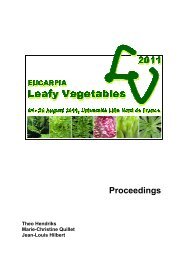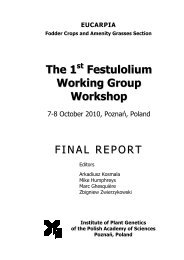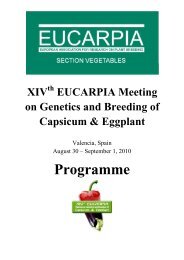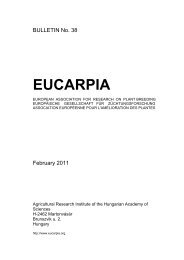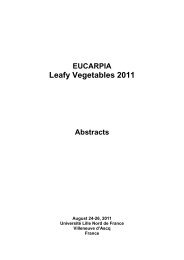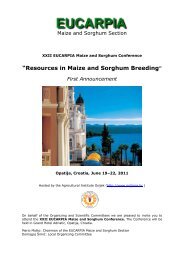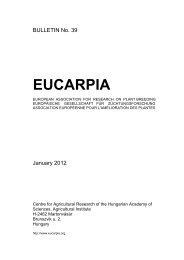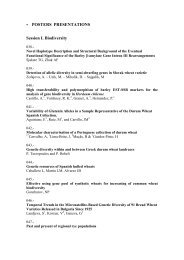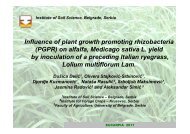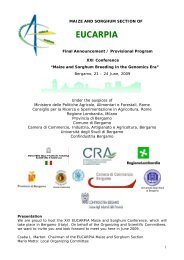Plant breeding for organic and sustainable, low-input agriculture
Plant breeding for organic and sustainable, low-input agriculture
Plant breeding for organic and sustainable, low-input agriculture
You also want an ePaper? Increase the reach of your titles
YUMPU automatically turns print PDFs into web optimized ePapers that Google loves.
Breeding <strong>for</strong> <strong>organic</strong> greenhouse production in zucchini squash<br />
S. Manzano 1 , H. Bos 1 , M.A Suarez 1 , J. Ferre 1 , C. Payán 2 , P. Gómez 2 <strong>and</strong> M. Jamilena 1<br />
1 Department of Applied Biology. University of Almería, Spain.<br />
2 Department of <strong>Plant</strong> Breeding <strong>and</strong> Biotechnology, IFAPA Almería, Spain.<br />
The production of zucchini squash under <strong>organic</strong> greenhouse conditions in the southeast of Spain<br />
requires the development of new varieties which not only satisfy the needs of growers but also<br />
the fruit quality that European consumers dem<strong>and</strong>. In collaboration with <strong>organic</strong> growers, the<br />
University of Almería has started a zucchini <strong>breeding</strong> program, the main goal of which is the<br />
development of parthenocarpic varieties adapted to <strong>low</strong>-<strong>input</strong> production in greenhouses.<br />
Parthenocarpy is an essential trait <strong>for</strong> zucchini <strong>organic</strong> greenhouse production, since the use of<br />
synthetic hormones <strong>for</strong> fruit set is a conventional practice that is prohibited in <strong>organic</strong> <strong>agriculture</strong><br />
<strong>and</strong> the use of pollinating insects is insufficient <strong>for</strong> winter productions.<br />
L<strong>and</strong>races of zucchini squash derived from the Spanish COMAV germplasm bank, as well as a<br />
number of hybrids from different seeds companies were evaluated in two variety trials that were<br />
carried out under <strong>organic</strong> greenhouse conditions in the research centre of IFAPA-Almería <strong>for</strong><br />
Spring-Summer 2005, <strong>and</strong> in the greenhouse of an <strong>organic</strong> grower <strong>for</strong> Spring-Summer 2006.<br />
Both essays were done in absence of pollinating insects, but fol<strong>low</strong>ing the recommendations<br />
proposed by <strong>organic</strong> growers. In each trial, the field plan was a r<strong>and</strong>omized complete block<br />
design with three blocks, <strong>and</strong> 6-10 replicates per block, <strong>for</strong> each cultivar.<br />
In addition to the general per<strong>for</strong>mance of a number of commercial varieties <strong>and</strong> l<strong>and</strong>races under<br />
<strong>organic</strong> greenhouse conditions, it was evaluated the parthenocarpic potential of each material <strong>and</strong><br />
the quality of parthenocarpic fruits, including their postharvest storage potential. In the first trial,<br />
the evaluation was carried out on a number of Spanish l<strong>and</strong>races. The most parthenocarpic<br />
materials were then selected <strong>and</strong> compared with commercial hybrids in a second variety trial<br />
grown in collaboration with an <strong>organic</strong> grower association in Almería. Longitudinal <strong>and</strong><br />
transversal fruit growth rates be<strong>for</strong>e <strong>and</strong> after f<strong>low</strong>er anthesis al<strong>low</strong>ed us to determine the level<br />
of parthenocarpy in each variety. In most of the commercial varieties non-pollinated<br />
parthenocarpic fruits reached a commercial size, although the quality of some of the fruits<br />
diminished considerably. In many of the analysed l<strong>and</strong>races the fruits of non-pollinated f<strong>low</strong>ers<br />
aborted a few days after anthesis. Nevertheless some of the evaluated l<strong>and</strong>races showed a level<br />
of parthenocarpy <strong>and</strong> fruit quality comparable to that of the commercial hybrids used as the<br />
positive control. The most parthenocarpic l<strong>and</strong>races <strong>and</strong> hybrids under <strong>organic</strong> conditions, but<br />
also those that developed fruit with superior quality <strong>and</strong> better postharvest conservation, are<br />
being selected as the starting plant material <strong>for</strong> an <strong>organic</strong> <strong>breeding</strong> program in zucchini squash.<br />
34




